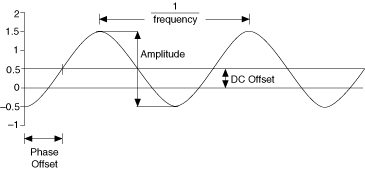Standard Function Waveform Description Overview
Instrument vendors typically have different definitions for waveform properties. In order to achieve a consistent waveform description between different instrument vendors, this class driver provides waveform property definitions that must be followed when developing instrument drivers. The definitions for these waveform properties are as follows:
Waveform TypeThe overall "shape" of one period of the standard waveform. This specification defines six waveform types: Sine, Square, Triangle, Ramp Up, Ramp Down, and DC.
AmplitudeThe difference between the maximum and minimum waveform values, or the peak-to-peak voltage value.
DC OffsetThe difference between the average of the maximum and minimum waveform values and the x-axis (0 volts). A positive DC offset places the middle of the waveform above the x-axis, while a negative DC offset places the middle of the waveform below the x-axis.
FrequencyThe number of waveform cycles generated in one second.
Start PhaseSpecifies the waveform's horizontal offset. The units are degrees of one waveform cycle. For example, a 180 degree phase offset means output generation begins half way through the waveform. A start phase of 360 degrees offsets the output by an entire waveform cycle. It is therefore identical to a start phase of 0 degrees.
The following illustration diagrams these properties.

Illustration of Basic Waveform Properties
Duty CycleA square waveform requires an additional parameter to configure the duty cycle of the waveform. Duty cycle is defined as the percentage of time during one cycle for which the square wave is at its high value.
